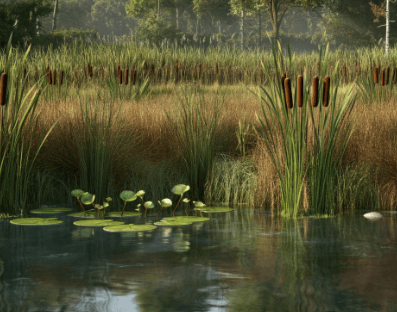Wetlands cover about 5.5% of the total area of the United States, yet many property owners are unsure of how to manage or use them effectively. If you’re asking yourself what to do with wetlands on your land, you’re not alone—these unique ecosystems can present both challenges and opportunities. Wetlands are vital for improving water quality, preventing floods, and supporting diverse wildlife. For property owners, properly managing wetlands can increase land value or unlock hidden potential. Steve Daria and Joleigh, renowned real estate investors and land buyers for cash, specialize in helping landowners make the most of their properties, including wetlands. Whether you’re considering selling or looking for advice, Steve and Joleigh bring their expertise to the table. Take the first step today—book a free discussion with them to explore your options and discover what to do with wetlands on your land.
Key Points
- Understand the Wetlands on Your Property: Start by identifying the type of wetlands you have, as each type serves a unique environmental purpose. This will help you understand any restrictions or opportunities connected to your land.
- Preserve and Protect Natural Ecosystems: Wetlands control floods, improve water quality and support wildlife. By maintaining their natural state, you contribute to the environment and potentially increase the appeal of your land.
- Consider Building Controlled Access: If the wetland is accessible, adding walking trails or observation areas may enhance the recreational use of your property. Small steps like these won’t harm the ecosystem but can add functional value to your land.
- Explore Economic Opportunities: Wetlands can sometimes be used for agricultural projects like aquaculture or growing wetland-specific plants. Alternatively, you may be able to sell conservation rights to organizations focused on protecting natural resources.
- Consult Experts for the Best Approach: Managing wetlands can get tricky, especially with regulations in place. Working with experts like Steve Daria and Joleigh, who specialize in real estate and land purchases, can help you find the best way to maximize the value and use of your land.
What are wetlands, and why are they important?
Wetlands are unique areas of land that are covered with water, either permanently or for parts of the year.
They include marshes, swamps, and bogs and are home to various plants and animals that thrive in wet conditions.
Wetlands are vital to the environment, serving as natural sponges that absorb excess water, mitigate flooding, and prevent soil erosion.

They also work as nature’s filters, cleaning and improving water quality by trapping pollutants before water reaches rivers or lakes.
Economically, wetlands can be valuable as they offer opportunities for eco-tourism, sustainable fishing, and even growing crops like rice.
Protecting wetlands also helps fight climate change, as they store large amounts of carbon that would otherwise contribute to global warming.
If you’re wondering what to do with wetlands on your land, consider preserving them to enjoy these benefits while potentially increasing your property value.
These ecosystems are a critical part of the natural world that support both biodiversity and human life in extraordinary ways.
Get Started: Get Your Cash Offer Below…
We are direct land buyers. There are no commissions or fees and no obligation whatsoever. Start below by sharing where your property is and where we can send your offer…
How can I identify if I have wetlands on my land?
Determining if wetlands are present on your property involves close observation and a clear understanding of their defining features.
Start by looking for areas that seem to stay wet or waterlogged for extended periods, especially after rain.
Wetlands often have specific types of plants, like cattails, reeds, or water lilies, which thrive in soggy or marshy conditions.
Examine the soil in these areas—wetland soils are typically dark, rich in organic matter, and often emit a distinct rotten egg odor due to low oxygen levels.
You might also notice standing water or a high water table during certain times of the year.
If you’re unsure, consult a local wetlands expert or environmental consultant to help with an assessment.
They may use maps, soil surveys, or even visit your property to confirm.
Understanding if wetlands are present is important because these areas are often subject to legal protections and come with both responsibilities and opportunities.
Knowing what to do with wetlands on your land can help you make informed decisions about their care, use, or preservation.
What are my options for safely using wetlands on my land?
- Conserve and Preserve the Wetlands: Protecting your wetlands through conservation programs can provide tax breaks and help the environment. Understanding what to do with your land’s wetlands can lead to financial and ecological benefits.
- Use Wetlands for Eco-Tourism: To generate income, turn your wetlands into eco-tourism attractions, such as bird-watching trails or educational tours. This is a sustainable way to explore what to do with wetlands on your land while preserving their beauty.
- Implement Sustainable Agriculture or Aquaculture: Wetlands can support farming activities like growing wild rice or raising fish, blending productivity with sustainability. Knowing what to do with wetlands on your land can help maximize their potential responsibly.
- Create a Recreational Space: Engage in low-impact recreational activities like kayaking or hiking to enjoy the wetlands without harming their ecosystem. This approach keeps the natural habitat intact while allowing you to use your land.
- Enroll in Mitigation Banking Programs: Use mitigation banking to offset development impacts by protecting or restoring wetlands. This balances land use and environmental protection, ensuring your actions comply with regulations.
How do I know which wetlands activities are permitted?
Determining allowable activities in wetlands involves a thorough review of local, state, and federal regulations to ensure compliance.
Start by checking with your local environmental or zoning office, as rules can vary depending on the location of your property.
Generally, activities like filling, draining, or altering wetlands often require permits to ensure the area’s ecological balance is not disrupted.
It’s also important to assess the potential environmental impact of your plans.
Consulting with a wetlands expert or an environmental consultant can help clarify your options.
They can review your property and advise whether your proposed activities comply with current laws and regulations.
Remember that wetlands are often protected because of their vital role in flood control, water quality, and wildlife habitat.
Respecting these guidelines ensures you can safely use your land while remaining environmentally responsible.
Knowing what to do with wetlands on your land can help you make wise decisions that benefit both the environment and your property goals.
What restrictions apply to developing or modifying wetlands on my land?
1. Permit Requirements
Most wetland development activities, such as filling or construction, require special permits from local, state, or federal agencies.
These permits ensure the proposed work does not harm the environment or violate conservation laws.
You risk fines, penalties, or even being required to undo the changes without proper permits.
2. Protected Wetland Designations
Some wetlands are protected areas due to their importance to the ecosystem.
Protected wetlands have stricter rules, and modifications may be prohibited or only allowed under specific conditions.
Always check with local authorities to confirm if your wetlands fall under this category.

3. Limitations on Draining or Filling Wetlands
Regulations often restrict draining or filling wetlands, as these activities can disrupt water flow and harm wildlife habitats.
These processes are closely monitored and usually require extensive justification before being approved.
Considering such work, be prepared for compliance inspections and environmental impact assessments.
4. Buffer Zone Requirements
Some laws require leaving a designated buffer zone around the wetlands to protect their ecological functions.
You may not be allowed to build or excavate within a certain distance from the wetland boundary.
These rules help maintain the area’s natural balance and minimize the impact of human activities.
5. Restrictions on Harmful Activities
Wetlands laws often prohibit activities like dumping waste, introducing invasive species, or using harmful chemicals nearby.
These restrictions aim to protect the wetlands’ delicate ecosystem and water quality.
Adhering to these rules ensures legal compliance and preserves your land’s health and value for the future.
How do I get started with managing wetlands on my land?
Managing wetlands on your land involves a thoughtful approach to understanding and caring for these unique ecosystems.
First, assess your property to identify the wetland areas and any features that make them distinct, like standing water, specific plants, or unique soil types.
Next, familiarize yourself with local regulations or restrictions to activities in these areas to ensure compliance.
Consulting with experts in wetland management or environmental planning is smart, as they can guide you on sustainable practices that align with ecological and legal requirements.
You might also explore conservation programs that provide financial incentives for preserving wetlands and benefiting wildlife and water quality.
If you’re considering development or modifications, gather the necessary permits and engage with professionals specializing in wetlands.
To create a clear plan tailored to your goals, ask Steve Daria and Joleigh, seasoned real estate investors and land buyers, for cash.
They can offer expert advice and practical solutions for managing your property effectively.
Understanding what to do with wetlands on your land can help you make informed decisions that preserve their value and ecological importance.
Contact Steve Daria and Joleigh today to take the first steps toward successful wetlands management!
**NOTICE: Please note that the content presented in this post is intended solely for informational and educational purposes. It should not be construed as legal or financial advice or relied upon as a replacement for consultation with a qualified attorney or CPA. For specific guidance on legal or financial matters, readers are encouraged to seek professional assistance from an attorney, CPA, or other appropriate professional regarding the subject matter.
